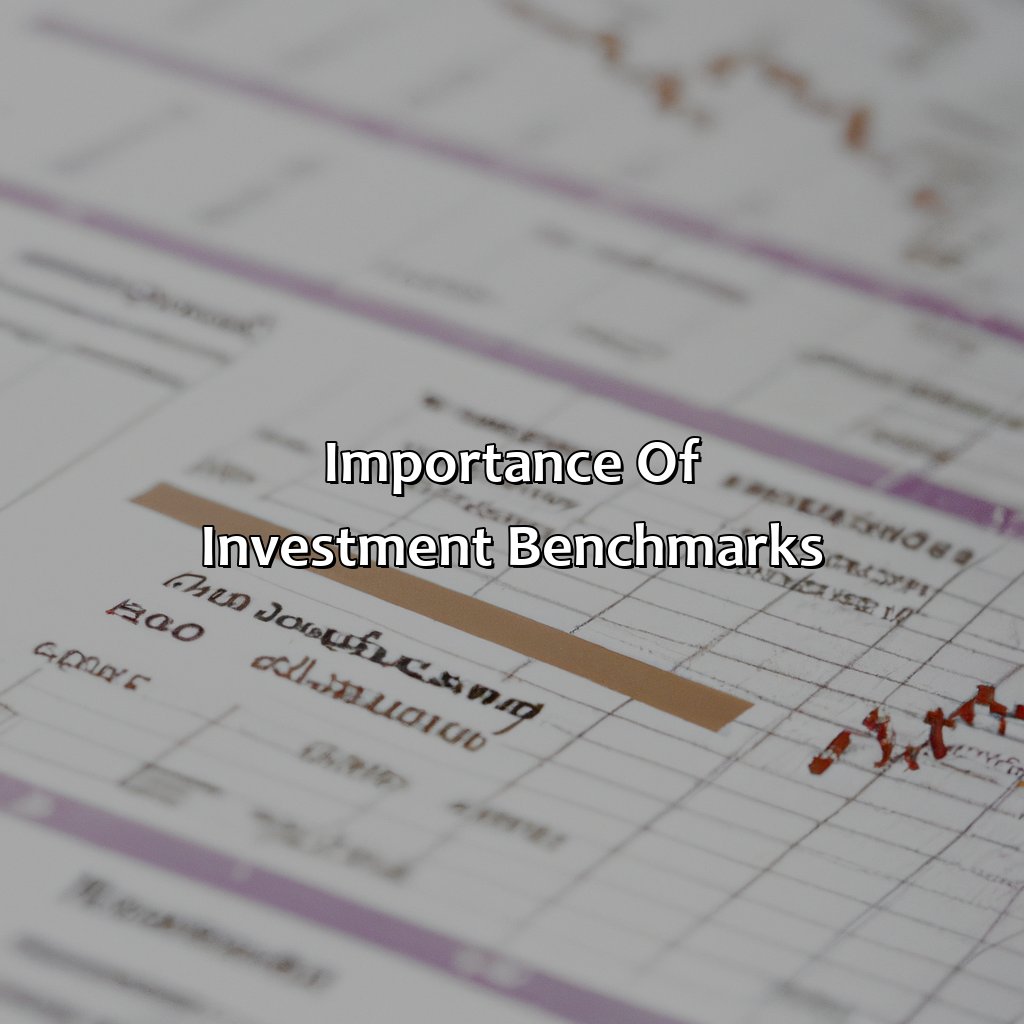What Is An Investment Benchmark?
Key Takeaway:
- Investment benchmarks are used to evaluate the performance of an investment portfolio by comparing it against a set of standardized criteria, such as a market index or asset class benchmark.
- There are three main types of investment benchmarks: market index benchmarks, asset class and style benchmarks, and manager universe benchmarks, each with its own unique set of features and uses.
- The importance of investment benchmarks lies in their ability to help investors set investment objectives, evaluate performance, and monitor portfolio risk, making them a valuable tool for both individual investors and institutional investors.
Are you looking to get the most out of your investments? Understanding investment benchmarks is the key to successful investing. You’ll learn how to use benchmarks to maximize return on your investments and meet your financial goals.
Types of Investment Benchmarks
To separate investment strategies, a benchmark is necessary. To help pick one, Types of Investment Benchmarks offer Market Index Benchmarks, Asset Class and Style Benchmarks, and Manager Universe Benchmarks. These solutions aid in comprehending the distinct benchmarks and how they connect to your particular investment strategy.

Image credits: retiregenz.com by Yuval Duncun
Market Index Benchmarks
Market index indicators are standard benchmarks used in investment to determine performance relative to the market. Here’s a table highlighting some key market index benchmarks and their respective asset classes:
| Benchmark | Asset Class |
|---|---|
| S&P 500 Index | US Large Cap Stocks |
| Dow Jones Industrial Average (DJIA) | US Blue Chip Stocks |
| Nasdaq Composite Index | US Technology Stocks |
| Russell 2000 Index | US Small Cap Stocks |
| MSCI EAFE Index | The developed international stock markets from Europe, Australasia, and the Far East. |
It’s essential to choose an appropriate market benchmark related to your portfolio or strategy while evaluating investments based on market index benchmarks.
The application of Market Index Benchmarks is not new but rather has been used since the invention of securities trading on organized exchanges.
If investment benchmarks were shoes, asset class and style benchmarks would be the trendy, versatile pair that go with everything in your portfolio.
Asset Class and Style Benchmarks
Investment Portfolio Standards by Asset Types and Investment Style
A portfolio benchmark is a standard that funds, managers, or investors use for determining profitability. The Asset Class and Style Benchmarks are ideal tools for measuring investment performance.
Below is an example of an Asset Class and Style Benchmarks Table:
| Asset Class | Style | Benchmark |
|---|---|---|
| Equities | Value | Russell 1000 Value Index |
| Fixed Income | Aggregate | Barclays U.S.Aggregate Bond Index |
| Alternatives | Real Estate | Morgan Stanley REIT Index |
The table above illustrates common asset classes and their respective investment styles alongside the benchmark typically used in each category.
An important note to consider with Asset Class and Style Benchmarks is that they are not tailored to specific portfolios. Therefore, it is highly recommended to adjust the benchmarks in line with the respective portfolio objective(s).
It’s crucial that investors select their benchmarks carefully as choosing inappropriate standards can lead to detrimental investment performance evaluations.
To ensure that one picks suitable benchmarks:
- One should establish how portfolios align with objectives.
- Investors should be particular about comparison groups of fund managers or passive investments.
- Evaluate non-benchmarked investments based on goals through appropriate selection of performance statistics that correspond with objectives.
“Trying to keep up with the Manager Universe Benchmarks is like trying to catch a greased pig – it’s slippery and you’ll probably end up with mud on your face.”
Manager Universe Benchmarks
When it comes to evaluating investment managers and their performance, the Manager Universe is a commonly used benchmark. This benchmark allows investors to compare their manager’s returns with those of their peers within the same investment style or strategy.
The table below provides examples of some popular Manager Universe Benchmarks and the associated investment style or strategy they represent.
| Benchmark | Investment Style/Strategy |
|---|---|
| S&P 500 | Large Cap Equity |
| MSCI EAFE | International Equity |
| Barclays AGG | Fixed Income |
It’s important to note that not all Manager Universe Benchmarks cover every investment style or strategy. Investors should carefully consider which benchmark aligns best with their portfolio’s specific needs.
When selecting a benchmark, investors should also take into account other factors such as fees, liquidity, risk tolerance, and overall investment goals. By doing so, they can better ensure that they are making informed decisions regarding their investments.
Don’t miss out on the benefits of utilizing Manager Universe Benchmarks in your investing strategy. Consider incorporating them into your portfolio analysis and stay ahead of the curve in today’s ever-evolving market landscape.
Without investment benchmarks, it’s like driving without a GPS – you have no idea where you’re going and will likely end up lost and broke.
Importance of Investment Benchmarks
Gaining insight into investment benchmarks is key. To assess investment performance, set objectives, and monitor risk, you must delve into the subsections. Doing this will help put a strategy in place to increase profit and reduce risk.

Image credits: retiregenz.com by James Arnold
Evaluating Investment Performance
Evaluating the success of an investment is crucial, and one way to do it is through measuring performance against a benchmark. Investment benchmarks refer to a set standard that represents the financial market or a specific investment sector.
Investment managers use benchmarks to determine how well their investments are performing and to evaluate investment strategies against the market trends. The benchmarks help investors identify their portfolio’s strengths and weaknesses, making it easier for them to make informed decisions.
Knowing the appropriate benchmarks for specific investments can be challenging but necessary. For instance, if an investor has shares in technology companies, then they should evaluate their performance against the Nasdaq Composite Index instead of Dow Jones Industrial Average or S&P 500 Index.
Investors who fail to use investment benchmarks may miss out on understanding how well their portfolios are performing compared to peers or other investment instruments. Therefore, keeping track of appropriate benchmark indexes can ensure better results in reaching your financial goals.
Remember, setting investment objectives and goals is just like making a to-do list for your finances, except the only thing that gets checked off is your bank account balance.
Setting Investment Objectives and Goals
Investors must define their financial aims and goals before investing. This initiates the development of a personalized investment plan that can vary from conservative to aggressive approaches. Precise analysis of assets, risk tolerance and duration are essential in managing a successful portfolio.
Selecting appropriate benchmarks is crucial to stay on track with investment goals, as they enable effective performance measurement of investments. A benchmark is a chosen reference point for comparison with the return rate of an investment. Without them, investors may underestimate or overestimate its success.
Diversifying your portfolio is vital to spreading out risks and rewards due to varying market conditions. An investor should set up different types of investments, such as stocks, real estate or mutual funds and continually monitor performance through suitable benchmarks to reach desired results.
Studies have illustrated that over 80% of money managers don’t perform better than the market average index such as S&P500 or Dow Jones Industrial Average indices. This emphasizes that having the appropriate benchmarks gives investors a clear understanding required for taking relevant decisions during market fluctuations.
(Source: Forbes)
Better to monitor portfolio risk than to risk monitoring your portfolio.
Monitoring Portfolio Risk
Investment benchmarks are crucial for Monitoring Portfolio Risk. Benchmarking helps investors to assess the performance of their investment portfolio compared to industry standards and peers. By comparing the returns earned on investments against a benchmark, investors can identify if their portfolio is underperforming or outperforming. Moreover, benchmarking assists in determining the risk profile of an investment portfolio, which aids in constructing an efficient asset allocation strategy.
Knowledge of the market and fluctuations in the market is important for monitoring portfolio risk. A well-chosen investment benchmark aids investors’ monitoring efforts by providing them with information about current market trends. It alerts investors to changes in investment conditions and opens up avenues for new opportunities that match their portfolio requirements.
It’s essential to choose a relevant and accurate benchmark that represents the most appropriate comparison group for an investor’s portfolio. The chosen benchmark should reflect an investor’s investment strategy and goals while also accounting for local and global economic variables.
According to Investopedia, “A good benchmark must be reflective of the operational performance of a company or sector without influence from financial engineering or overly aggressive accounting“. Therefore, careful consideration before selecting a suitable investment benchmark plays a significant role in monitoring portfolio risk accurately.
Overall, using appropriate benchmarks provides valuable insights into investment performance, aids decision-making processes across asset allocations thus affecting overall profitability potential.
Choosing the right benchmark is like picking the right outfit – it can either make you look sharp or like a total disaster.
Selection and Use of Investment Benchmarks
Choose benchmarks for your investments. Compare them to your portfolio strategy. Think about the market and what you want to achieve. Each sub-section gives you the information you need to get the most of your benchmark selection and achieve your goals.

Image credits: retiregenz.com by Harry Duncun
Comparing Benchmarks to Portfolio Strategy
When it comes to benchmarking investment strategies, it’s essential to compare and contrast them with portfolio strategy. The aim is to determine if they are aligned with the investor’s goals.
The following table shows a comparison of benchmarks and portfolio strategy:
| Benchmarks | Portfolio Strategy |
|---|---|
| Used as a standard for evaluating investment performance | Used as a customized plan based on an investor’s risk profile, financial goals, and preferences |
| Applies to a broad market index or sector-specific index | Customized according to the individual investor’s needs and objectives |
| Provides a method for assessing whether an investment is adding value or not | Creates an optimized investment plan that caters explicitly to the investor’s financial goals |
It is useful to note that while benchmarks are often used as standards for evaluating investments, portfolio strategy provides investors with a personal approach specifically designed to meet their various needs.
Throughout history, benchmarking has been tested and evolved constantly. Initially introduced through management consulting practices in the ’70s, the concept of comparing performance against set standards became prevalent in the ’80s when technology allowed easier access to data. It subsequently developed into numerous forms that catered uniquely to different sectors of finance, gradually reaching its current appeal in modern-day capitalism across diverse industries.
Choosing the right investment strategy is like finding a needle in a haystack, except the haystack is on fire and your eyes are closed.
Considering Market Conditions and Investor Objectives
Investment benchmarks play a critical role in measuring performance and guiding investment strategies. Consideration of market dynamics and investor goals are crucial in the selection of an appropriate benchmark. Market conditions influence the selection of a relevant benchmark, while investors’ objectives define the desired outcome. Therefore, considering these two variables is key to achieve relevancy between investments and returns.
Investors must determine their investment objectives before selecting a benchmark, as it helps them choose an appropriate index comprehensively. A thorough understanding of individual goals enables investors to achieve the best possible results aligned with their desires. For instance, an investor interested in beating the market will select an active manager who outperforms specific benchmarks carefully.
Over time, investors’ objectives may evolve as market dynamics change; therefore, they must review existing benchmarks regularly. Slight variations from original goals could mean selecting new indexes to track portfolio performance suited to specific financial needs.
Consider Kevin – a novice investor who rushed his way through photo-sharing app IPOs based on past success. Despite gaining immediate profits, he regretted not establishing robust investment acumen early enough. He then consulted his banker on investing in a home loan insurance company with better long-term forecasts and selected a relevant index tracking its performance resulting in sustained gains.
Some Facts About Investment Benchmarks:
- ✅ An investment benchmark is a standard index used to measure the performance of an investment portfolio. (Source: Investopedia)
- ✅ Benchmarking enables investors to evaluate how well their portfolio is performing compared to the market as a whole. (Source: The Balance)
- ✅ Common investment benchmarks include the S&P 500, the Dow Jones Industrial Average, and the NASDAQ Composite Index. (Source: US News)
- ✅ Benchmark indices are typically composed of the largest and most commonly traded securities in the market. (Source: The Street)
- ✅ An investment manager’s performance is often judged relative to a chosen benchmark index. (Source: Morningstar)
FAQs about What Is An Investment Benchmark?
What is an investment benchmark?
An investment benchmark is a standard against which the performance of an investment portfolio or investment manager is measured. It provides a point of reference for investors to evaluate the performance of their portfolios and assess the effectiveness of the investment decisions made by their managers.
Why is it important to have an investment benchmark?
Having an investment benchmark is important because it allows investors to track the performance of their portfolios over time. The benchmark serves as a benchmark against which to measure the effectiveness of their investment strategies and to identify areas where improvements can be made.
What are some commonly used investment benchmarks?
There are several commonly used investment benchmarks, including the S&P 500 Index, the Dow Jones Industrial Average, the NASDAQ Composite Index, and the Russell 2000 Index. These benchmarks provide a point of reference for investors seeking to evaluate the performance of their portfolios.
How are investment benchmarks calculated?
Investment benchmarks are calculated using a variety of methods, depending on the type of benchmark being used. For equity benchmarks, such as the S&P 500, the benchmark is typically calculated based on the performance of a set of underlying stocks. For fixed income benchmarks, such as the Barclays Capital Aggregate Bond Index, the benchmark is typically calculated based on the performance of a set of underlying bonds.
What are the benefits of using an investment benchmark?
The benefits of using an investment benchmark include the ability to measure the performance of an investment portfolio against a standard, which allows investors to identify areas where improvements can be made. Additionally, using a benchmark can help investors determine whether a particular investment strategy is working effectively and provide a point of reference for making investment decisions.
How should I select an investment benchmark for my portfolio?
When selecting an investment benchmark for your portfolio, it is important to consider your investment goals and objectives, as well as the asset classes and investment strategies you are using. You should also consider the characteristics of the benchmark, such as its composition and performance history, to ensure that it is an appropriate point of reference for evaluating the performance of your portfolio.


